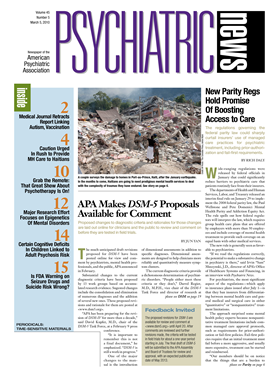For decades, researchers have sought ways to intervene early after traumatic events in hopes of preventing posttraumatic stress disorder (PTSD).
As far back as World War II, “narcotherapy” used medication to put soldiers to sleep for a week to gauge its influence on later psychological outcomes, with mixed results. Studies have looked at the effects of beta blockers, anxiolytics, and opiates without producing clinically useful conclusions. Research published last year in Biological Psychiatry by Richard Bryant, Ph.D., and colleagues found that early morphine use was associated with reduced levels of PTSD symptoms, although not with reductions in diagnosed PTSD.
Now, a new study suggests a protective association between morphine use and later development of PTSD.
Using morphine immediately following injury or during resuscitation or early trauma care led to significantly less risk of PTSD (odds ratio 0.47, p<0.001), reported Troy Lisa Holbrook, Ph.D., and colleagues from the Naval Health Research Center and EPI-SOAR Consulting, both in San Diego. They reported their findings in the January 14 New England Journal of Medicine.
The study could not determine causation, and just how morphine might act to prevent PTSD is not clear. Some previous researchers have hypothesized that pain is the culprit, and that anything that reduces pain will reduce the likelihood of PTSD, according to Holbrook and colleagues. Others have hypothesized that opiates may work in the central amygdala to dampen fear and interfere with the reactivation of memories of the traumatic event.
“[T]he adrenergic activation of the amygdala during the traumatic event facilitates encoding of traumatic memories,” wrote Matthew Friedman, M.D., Ph.D., executive director of the National Center for PTSD at the VA Medical Center in White River Junction, Vt., in an editorial accompanying Holbrook's article. More research is needed to explain the overlapping effects of morphine in producing analgesia and suppressing adrenergic activity, but the work of Holbrook's group fits in with current ideas about the “adrenergic mediation of fear-conditioned traumatic memories,” said Friedman.
The researchers reviewed records of 696 U.S. service members from the U.S. Navy–Marine Corps Combat Trauma Registry Expeditionary Medical Encounter Database. These troops had sustained a variety of wounds, but those with serious traumatic brain injuries were excluded because morphine was contraindicated in their cases. PTSD was assessed between one and 24 months after the injury using DSM-IV criteria.
Morphine was given either at battalion-aid stations or at surgical units, within one hour of injury in 71 percent of cases. Dosing of morphine followed standard protocols, but the authors said the protective effect of morphine did not depend on dose.
No data were available on the effect of long-term use of opiates, only on its use during acute trauma care and resuscitation, said Holbrook, in an e-mail interview. “We are unable to speculate on whether long-term opiate use would produce similar results.”
A lower percentage of subjects with more severe injury or amputation were diagnosed with PTSD.
“Injury severity is not necessarily associated with pain,” Holbrook noted. The “somewhat puzzling” inverse association of PTSD with amputations and serious injuries was not clinically significant and was diminished by the small absolute numbers of patients and small observed effects in those categories, she said.
About 61 percent of the 243 patients who later were diagnosed with PTSD received morphine, while 76 percent of the 453 who did not develop PTSD got the drug. After adjusting for several factors, including injury severity, the data indicated a reduced risk of developing PTSD. Few other psychotropic drugs were administered during the early stages of treatment. About 9 percent of patients were given benzodiazepines, but that treatment produced no differences in PTSD incidence.
The study, the researchers noted, “provides suggestive, observationally derived evidence that use of morphine in trauma care may be protective against the subsequent development of PTSD after serious injury.”
Morphine is not the only compound that has been considered as a possible chemopreventive agent for PTSD after trauma. Other researchers are studying compounds like propranolol, neuropeptide Y, or interleukin-6.
Friedman cautioned in his editorial, however, that “preventing subsequent PTSD by the administration of morphine during resuscitation and early trauma care raises theoretical and practical questions that require rigorous follow-up.”
